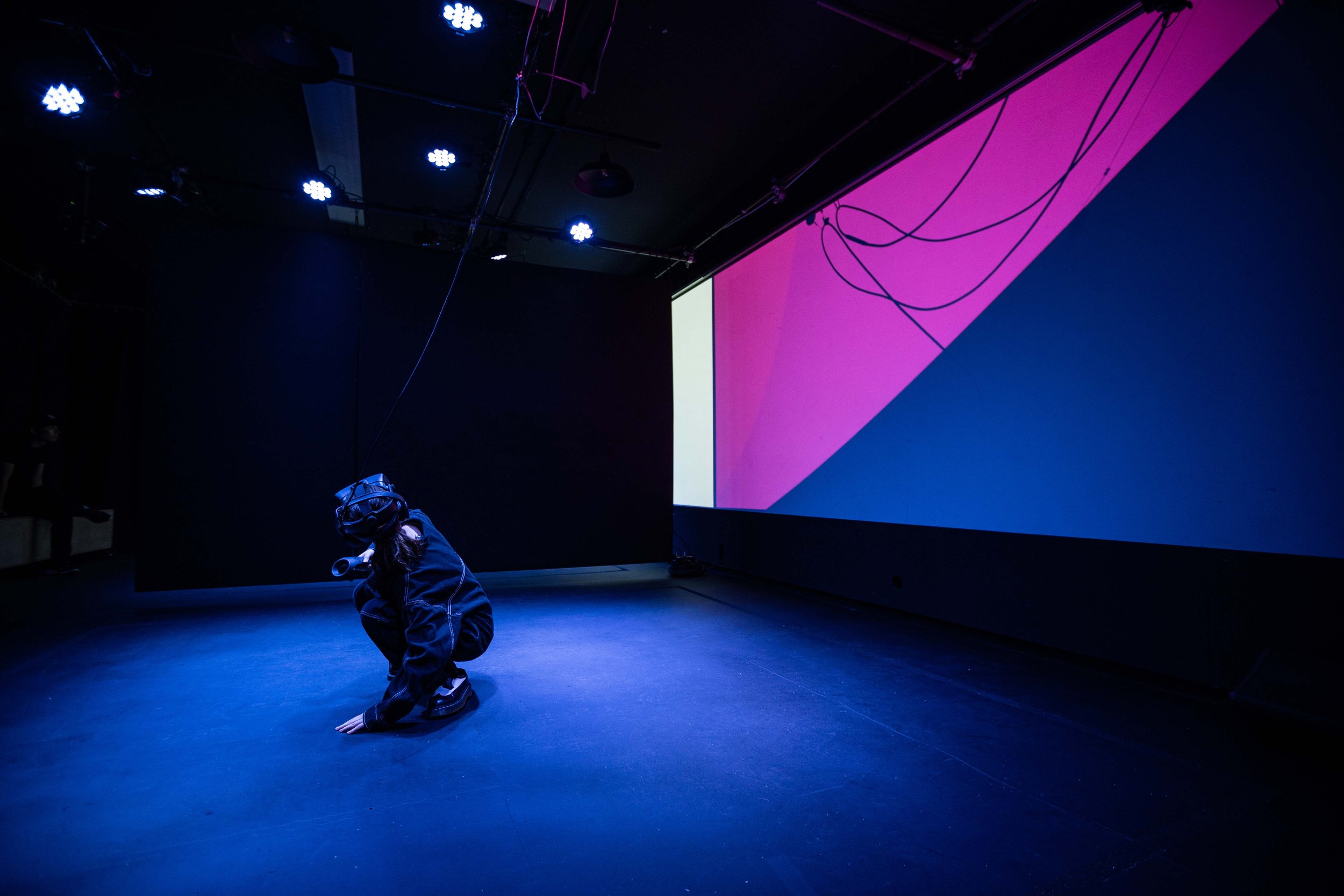On Ana Knežević's Circle of Resonance: Magnetic Flower (2023) and Sonic Geometry (2021) at CultureHub
Dylon Lamar Robbins
On Ana Knežević’s Circle of Resonance: Magnetic Flower (2023) and Sonic Geometry (2021) at CultureHub
September 11, 2023
Sound is a form of touch.
I was reminded of this as I looked at the orange and pink disks comprising the first of the blossoms in Ana Knežević’s VR piece, Magnetic Flower (2023). It wasn’t the image that prompted it, but the recording of a woman’s breathing that accompanied me as I wandered over its petals feeling drawn by the possibility of being immersed in light. I could feel as much as hear this breath, just as I could later hear-feel the chimes and bells, sine wave pitches, or the occasional footfall or air-conditioning hum from the room around me. In distinct ways, Knežević’s two VRs Magnetic Flower and Sonic Geometry encourage us to revisit our senses and to feel them anew as we meander in a space whose abstract geography of hues and intersecting planes prompts the paradoxical joy of feeling lost in an unfamiliar, yet tranquil, place.
In A Field Guide to Getting Lost, Rebecca Solnit has described “losing yourself” as a “voluptuous surrender.”[1] It is an otherwise desirable vulnerability, she adds, by which we practice “the art of being at home with the unknown.” I kept coming back to Solnit’s words as I walked, crawled, and rolled around on the floor through these spaces fashioned by Knežević. There were so many opportunities to feel surprised as I wandered through the rooms, through their colors and their sounds. After a leisurely trek with several rests upon the orange and yellow disks at the very heart of Sonic Geometry, I was startled by a step into green which emerged suddenly, for there are no paths or blazes in these places. Green comes on like a rush of buds and lianas, and a pitch that sounds like an error alert—a tinge of foreboding, honestly—but then gives way to other sounds as you become more familiar with the space. There is, after all, a sympathetic vulnerability that these spaces can permit you, that is, if you’re willing to let go while you’re there and, especially, if you’re willing to forget, or at least ignore, that you are also adrift with your goggles in an open room among strangers that you can’t see, but, rather, smell perhaps, and certainly hear. If you are willing, finally, to allow your body to be affected, you can become acquainted with the intimate strangeness this individuating technology affords you in public, with the peculiar ambiguity of inhabiting two spaces at once. You might be able, even, to feel at home with it for a spell.
In describing the phenomenon of sympathetic resonance, the German physicist Hermann Helmholtz observed that “vibrating bodies” will “communicate their motion to the air,” and that this air, in turn, can “excite sympathetic vibrations” in yet another “body” provided their frequencies may align.[2] This is not—like gravity or magnetism, for instance—an action at a distance, for it is about the play and dance of air upon bodies. This is, indeed, the measure of resonance. And if we let his material observations take flight as metaphor—his own thought, ineffect, already informed by the sway of metaphor in comprehending music’s play upon the human senses—we can appraise part of the underlying, working premises of Knežević’s approach in Circle of Resonance: that we are, in other words, bodies affected by, and affecting upon, other bodies through resonance.
The two works comprising this circle of resonance permit, moreover, so many spiraling, circular itineraries through their resonant and resonating cyclical structures that our paths there might only intersect without ever really coinciding. While the sequence of the rooms in each is fixed, we move through them variedly. One set of sounds gives way to another, and these colors will soon become yet others, depending, of course, upon the paths you find, and depending upon whether you adopt an angular, random walk or a peacefully steady stroll. Results may vary, fortunately, so expect only to experience.
In Sonic Geometry, I should add, be sure to linger in the place with an orange and yellow horizon. You can lie there for a while if you like. (In fact, you should.) From different points within this space, sounds can help you feel the planes of color as you lie upon them. The chime tolls with your heartbeat, and you can have the experience of being enveloped in color in a way that makes you remember what that was like before you ever entered the virtual space, before you ever slipped the VR googles over your head, before you even walked through the door to the gallery, before you had a name or, hopefully, any sense of self.
Knežević wants us to know that walking can do that to you.
[1] Solnit Rebecca. 2006. A Field Guide to Getting Lost. New York: Penguin.
[2] Helmholtz, Hermann von. 1895. On the Sensations of Tone as a Physiological Basis for the Theory of Music. 3d ed. London and New York: Longmans Green.
Dylon Lamar Robbins is an Associate Professor at NYU where he is the Director of the Center for Latin American and Caribbean Studies. His research and writing involves media and materiality, sound, spirit writing and phonography in Latin America and the Caribbean, with specific interests in the history of experimental phonetics, medical criminology, and experimental filmmaking.



